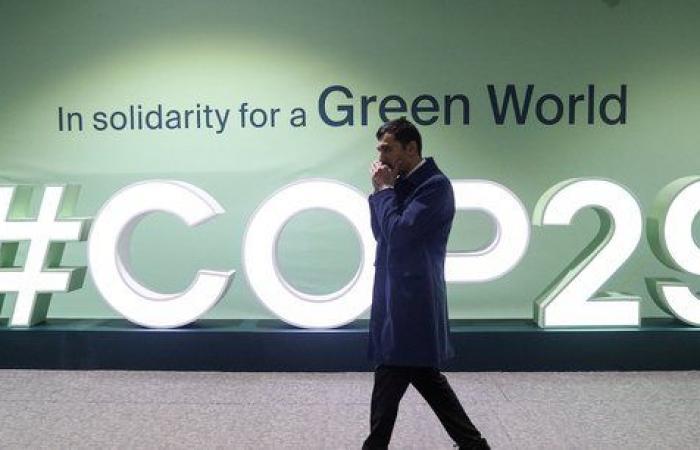One day before the theoretical end of COP29 in Baku, country delegations are on the verge of a nervous breakdown. In any case, this is what emerges this Thursday from the latest official declarations. “Let’s be frank. There are still many significant differences”admitted around noon Antonio Guterres, Secretary General of the UN to the press.
A few minutes earlier, it was John Podesta, the representative of the United States, the second largest CO2 emitter in the world, who came out of the woodwork: “We are, frankly, deeply concerned about the glaring imbalance in the text at this point. » His Chinese counterpart, the first country on the podium for carbon emissions, followed suit a little later in the day. “The current text contains many elements which are neither satisfactory nor acceptable to China”Xia Yingxian said soberly.
COP29: “The climate transition will accelerate, because investing in it becomes profitable” (Bertrand Piccard, explorer)
Not wanting, in his words, “sweeten”Wopke Hoekstra, the European Union negotiator and European Commissioner for Climate Action, considered that the current draft agreement was “clearly unacceptable”. But it was undoubtedly Samoan Cedric Schuster, representative of small island states, among the most impacted by climate damage, who was the most scathing: “The time for political games is over. We cannot have a decision (…) that goes against the Paris agreement for the climate. »
Aid to poor countries, still an object of discord
Why such tension? This results from the latest version of the text published last night by the Azerbaijani presidency of the COP. A 10-page provisional document, which “caricatures the positions of developed and developing countriesaccording to Joe Thwaites, of the NGO NRDC (Natural Resources Defense Council), to AFP. Inside, two diametrically opposed options, which go to the heart of COP29: increasing aid from rich and industrialized countries to developing countries which are, de facto, the most affected by the harmful effects of climate change.
Until then, this envelope was 100 billion euros per year, well below real needs, estimated at least ten times more. Defended by developing countries, the financing of this “new quantified collective objective” (NCQG), would be according to “option 1” of the last draft agreement, supposed to be financed exclusively by money from developed countries ( most being located in the Western bloc, such as the United States, the EU or Japan). A modality which follows the philosophy of the UN texts, which stipulate that these States are the only ones to contribute, by virtue of their responsibility as historical polluters.
COP29: rich countries called to finance 440 to 900 billion per year for climate solidarity
Furthermore, in this first option, at least 1,000 billion dollars per year would be provided by public money from rich countries, and by associated private funds. And this, “over the period 2025-2035”and thanks to more donations than bank loans. A demand from poor countries, many of which are insolvent, being already very indebted due to other bank loans, whether these come from traditional commercial banks, or public development banks (such as the World Bank, the French AFD , the German GIZ, etc.).
Reflecting the position of rich countries, the second option plans a similar financial target of at least $1 trillion per year “by 2035”. But, difference, this one would include “all sources of finance”with public money from each country in the world, private funds, or even new global taxes, for example on aviation or maritime transport. But, a big point of tension, this option does not quantify the commitment of rich countries, which since the start of the summit have said they want to wait before proposing a new amount. Which is not acceptable to developing countries. Option 2 also satisfies rich countries because it broadens the base of contributors to climate financial aid.
With, behind this option, the desire of the Western bloc to oblige, within the UN framework, China or the Gulf countries, nations with considerable financial means, and whose CO2 emissions are very significant. A perspective categorically rejected by China, which does not want to see the money it already gives to countries in the South be counted in the “new quantified collective objective”. A way for Beijing to remain free in its financial cooperation on climate, which it already considers substantial.
Reasons to hope
“There is no doubt that the negotiations at this COP are tense. But at least there is a shared vision that financial aid for climate must increase. It is on the modalities that the negotiations are tense”analyzes Lola Vallejo, special climate advisor at the Institute for Sustainable Development and International Relations (IDDRI), and co-president of the UNFCCC, the UN work program on climate change mitigation.
Especially since traditionally, the States with the greatest political weight wait until the last day to show their trump cards. While no figure for the climate envelope has been set in stone until then, in the middle of the afternoon, the enormous “G77 + China” group, an alliance of 134 countries from the South, demanded to the EU, Japan or the USA ” at least “ 500 billion dollars in financing per year for the climate, by 2030.
Climate: G20 leaders fail to compromise
Furthermore, a third option would be on the table. She is pushed by the Australian Chris Bowen and the Egyptian Yasmine Fouad, the two ministers responsible for reconciling the positions. But, to date, it has not yet been revealed. Furthermore, a new version of the agreement is expected in the evening, this time with the exact amounts requested, promised the presidency of the COP.
But according to Lola Vallejo of IDDRI, the key point to reach a possible agreement is the following: “As long as we do not have a strong political resolution from key countries, we are witnessing a form of repetition of everyone's positions. » She adds: “There also remains some vagueness about the mechanism for monitoring the global assessment of climate actions, a process provided for by the 2015 Paris agreement. This is also part of the negotiation. »
An illustrative example of this fact: this Thursday, the EU called for more commitments to reduce global greenhouse gas emissions, blaming oil-producing countries. Saudi Arabia's scathing response: “The Arab group will not accept any text that targets a specific sector, including fossil fuels”said Saudi delegate Albara Tawfiq. Atmosphere…






